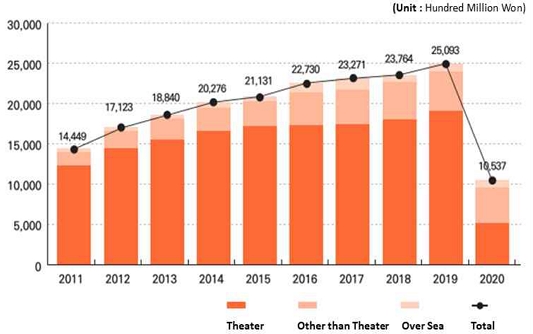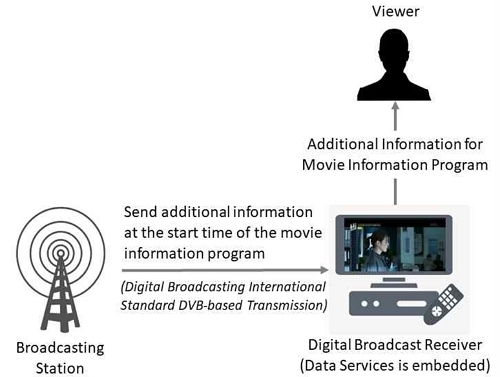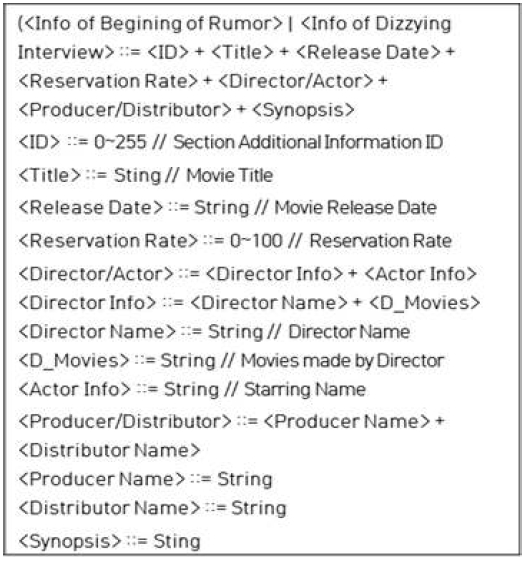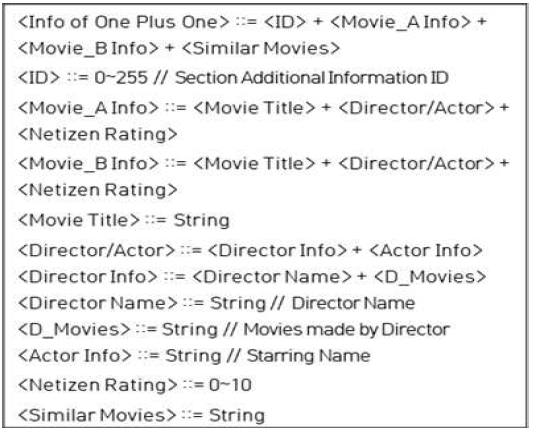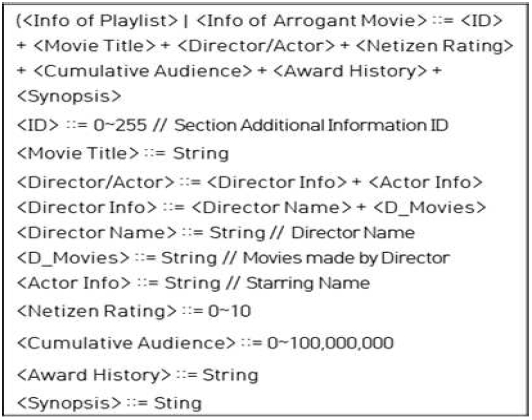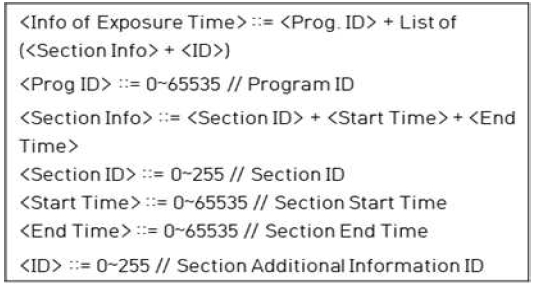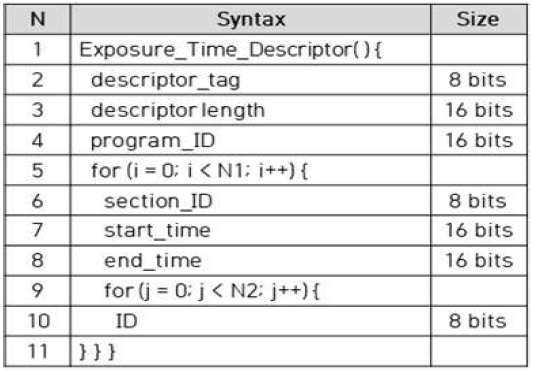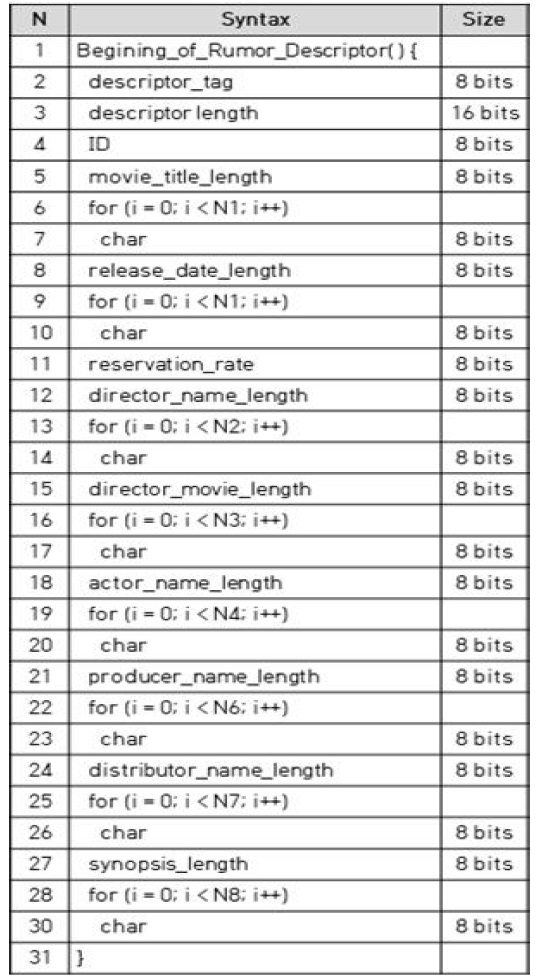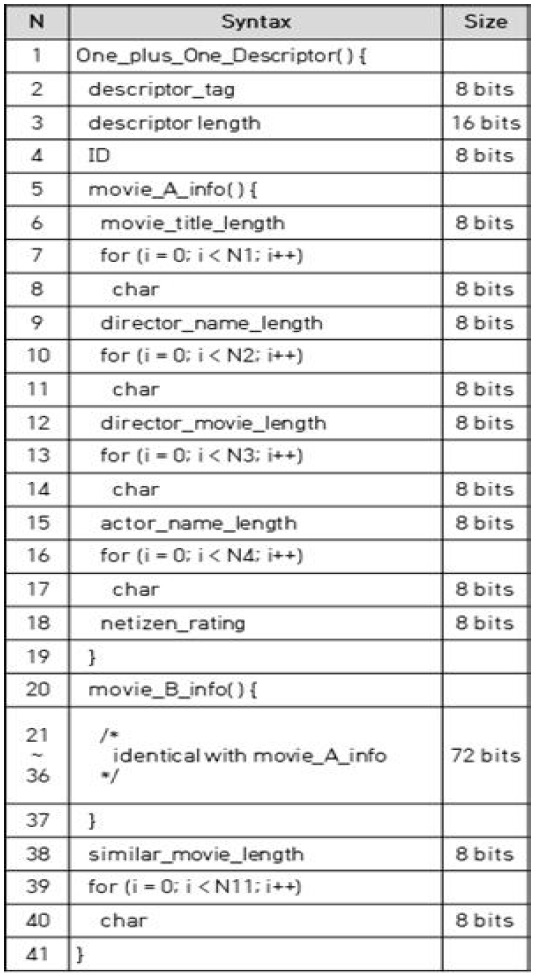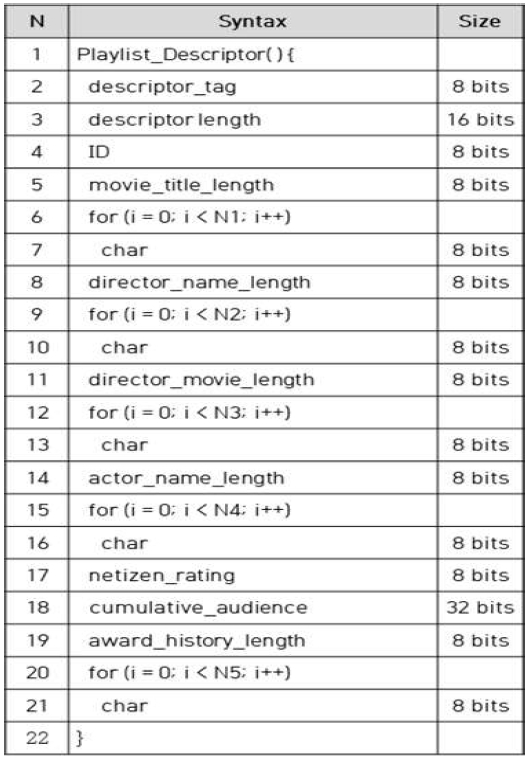
A Study on Data Service linked to Movie Information Program : focusing on the Transmission Method of Additional Information
Copyright ⓒ 2022 The Digital Contents Society
This is an Open Access article distributed under the terms of the Creative Commons Attribution Non-CommercialLicense(http://creativecommons.org/licenses/by-nc/3.0/) which permits unrestricted non-commercial use, distribution, and reproduction in any medium, provided the original work is properly cited.

Abstract
The movie industry, which has been hit hard by the COVID-19 crisis, is strategically taking advantage of a variety of factors that lead moviegoers to watch movies. For example, a movie introduction activity through a movie information program is a representative example in order to increase viewers' interest in a movie and induce viewing. Considering that a movie information program is an effective medium to increase viewers' intention to watch a movie, a study on data services linked with movie information programs is meaningful. This study devised a definition of additional information for a movie information program and a method of transmitting additional information, which are key topics in the study of movie information program-linked data service. Additional information definition was made for <I Like Movies>, a movie information program of KBS, and the additional information transmission method was devised based on the digital broadcasting international standard DVB-SI.
초록
COVID-19 사태로 인해 심각한 타격을 받은 영화산업은 영화 관객의 다양한 영화관람 요인을 전략적으로 활용하고 있는데, 시청자의 영화 관심도를 높이고 관람을 유도하기 위해 영화정보 프로그램을 통한 영화소개 활동을 대표적인 예로 들 수 있다. 영화정보 프로그램이 시청자들의 영화관람 의도를 높이는 효과적인 매체임을 고려할 때 영화정보 프로그램과 연동된 데이터서비스에 관한 연구는 의미가 있으며, 본 연구는 영화정보 프로그램 연동형 데이터서비스 연구에 있어서 핵심적인 주제인 영화정보 프로그램의 부가정보를 정의하고 부가정보의 전송방법을 고안하였다. 부가정보 정의는 KBS의 영화정보 프로그램인 <영화가 좋다>를 대상으로 이루어졌으며, 부가정보 전송방법은 디지털방송 국제표준 DVB-SI 기반으로 고안하였다. 본 연구는 데이터서비스의 응용 분야를 영화정보 프로그램으로 확장하며 영화산업에 새로운 홍보 전략을 제시한다는 점에서 의의가 있다.
Keywords:
Movie Information Program, Data Service, Digital Broadcasting, DVB-SI, Movie Industry키워드:
영화정보 프로그램, 데이터서비스, 디지털방송, 영화산업Ⅰ. Introduction
1-1 Research Background : Movie Industry Trends
Even in the early 2020s, few people predicted that the domestic movie industry would be in the current recession due to COVID-19. Since the first confirmed case in Korea on January 20, 2020, COVID-19 has dealt a huge blow to all industries in Korea, and the pattern of the impact varied by industry. For example, e-commerce, health, pharmaceuticals, etc. have been affected relatively little or recorded growth due to the pandemic, but oil refining, tourism and aviation have been severely damaged. Unfortunately, the movie industry, which uses movie theaters as its main distribution platform, is one of the industries that has suffered a relatively short-term loss in the ‘non-face-to-face’ era.
According to the <2020 Korean Movie Industry Settlement> [1], global market research firm <Comscore> published the global theater sales in 2020 to $12.4 billion, down 71% from $42.5 billion in 2019. In the case of the non-theater market, the decrease was smaller than that of the theater, but it also recorded 451.4 billion won, down 11.4% from the previous year. Overseas sales of Korean films were found to be $83.61 million (91.9 billion won), up 13.3% from the previous year due to the impact of global OTT sales. The combined sales of the above three major divisions were 1.537 trillion won, which is a decrease of 58.0% compared to 2019 (See Fig. 1).
According to the <2020 Korean Movie Industry Status Survey>[2], which is conducted by the Korean Movie Council every year, it is difficult to estimate the exact figure for the overall size of the Korean movie market since 2020 is an exceptional case. However, considering that commercial theaters usually account for about 50% of the total sales in the survey, the total size of the Korean movie market in 2020 is highly likely to have fallen to 4 trillion won.
In conclusion, if we were to describe the Korean movie market in 2020 in one word, it would not be an exaggeration to say that it started with COVID-19 and ended with COVID-19.
1-2 Related Works
Consumers generally search for information before consuming. This information-seeking behavior itself acts as a consumer experience and affects not only information acquisition but also subsequent attitudes and behaviors. In the case of movies, it can be seen as a high-level active consumption behavior that requires time allocation and location movement when consuming a movie at a movie theater.
Therefore, the movie information search is different from the general product or service. There are three main channels for acquiring movie information: traditional media such as newspapers and television, new media such as the Internet, and spread of information such as word of mouth [3,4].
The introduction of a movie in a movie information program also acts as an important factor in converting viewers into movie spectators. Because a movie is an experience product that is difficult to know about its quality before watching it, we feel a lot of risk of failure before consuming a movie. To reduce this risk, we search for a lot of information with various evaluation criteria, including movie advertisements, movie reviews, number of audiences, directors, genres. In addition, rather than direct marketing communication messages, audiences tend to use surrounding information to select movies. This is because acquiring movie information is the most effective in reducing uncertainty and risk factors in movie consumption. Specifically, movie-related articles or advertisements have a great influence on consumers' choosing a movie [5,6].
The role of a professional movie information program is important for direct movie selection. In the case of the publicity activities of the actors (of a movie about to be released) through movie advertisements or entertainment programs, it is effective to increase exposure to movies to secure awareness. However, the movie information program has more influence on consumer decision-making in that it provides reliable professional information to viewers and induces consumption [7].
1-3 Research Subject
According to the related research described above, it can be seen that the movie information program is an effective medium to increase the audience's intention to watch the movie. Therefore, it is meaningful to study a data service to increase viewers' interest in movies by providing the additional information that is not provided (or insufficiently provided) in a movie information programs.
This study deals with key research topics in the development of a movie information program-linked data service. Specifically, this study defined additional information of a movie information program and devised an additional information transmission method based on the digital broadcasting international standard DVB-SI (Digital Video Broadcasting-Service Information)[8] to provide the defined additional information to data service. In addition, since movie information programs generally consist of several sections to introduce various movies, this study designed a method of exposing the additional information of the movies introduced in the section at the time of the broadcast time of the section. That is, when a specific section of the movie information program is broadcast, additional information of movies introduced in the section is provided to the viewer.
This study is meaningful in that it expands the application field of data service to movie information programs and suggests a new marketing strategy direction for the movie industry that has been severely hit by the COVID-19 crisis.
Ⅱ. Additional Information Design
2-1 Additional Information Definition
The movie information program-linked data service ultimately aims to increase the viewer's intention to watch the movies (introduced in the movie information program) by providing additional information about the movies. To achieve this purpose, the contents of the additional information of the movie information program and the exposure time of the additional information should be appropriately designed based on the sections constituting the movie information program.
For example, if a movie information program consists of two sections, which introduces upcoming movies and then introduces hidden masterpieces, It would be appropriate to provide additional information such as the release schedule of the upcoming movie, director and actor information, and a reservation rate in the first section. And in the second section, it would be appropriate to provide additional information such as netizens' ratings and award history that support the fun and workability of the movie. As can be seen from the previous example, the data service should provide appropriate additional information at an appropriate time in accordance with the section composition of the movie information program to be linked.
In this study, <I Like Movies>[9], a movie information program of KBS, was selected as the movie information program to be linked with the data service (See Fig. 2). <I Like Movies> is a professional movie information program broadcasted on KBS from November 25, 2006. Unlike other broadcasters' movie information programs (e.g. MBC <Departure! Video Tour>, SBS <Access! Movie World>), <I Like Movies> is a national broadcast that is broadcast all over the country simultaneously and has no interim advertisements.
<Table 1> is a summary of the major sections that make up <I Like Movies>. Note that the composition of the sections may vary for each episode of <I Like Movies>. In order to define additional information for each section of <I Like Movies>, 50 college students were asked to watch several episodes of <I Like Movies>, and then what kind of additional information they wanted to gain from each section of <I Like Movies> was investigated. Additional information was divided into 9 types: movie release information(T1), advance reservation rate(T2), cumulative audience(T3), director/actor(T4), netizen evaluation (T5), award history(T6), synopsis(T7), producer/distributor(T8), and similar material movie information(T9). Then, the students were asked to select what additional information they wanted in each section. The number of desired additional information is not limited.
<Table 2> summarizes the survey result and <Table 3> shows the types of additional information selected by more than 50% of survey respondents by section. And <Table 4> to <Table 6> formally define the contents of the additional information for each section of <I Like Movies> based on <Table 3>.
2-2 Exposure Time of Additional Information
The movie information program-linked data service that this study aims at is an 'embedded' data service based on the international data broadcasting standard DVB-MHP[10]. The embedded data service has the characteristic that the execution code is stored in the digital broadcasting receiver in advance and is quickly executed when the viewer executes the data service [11].
As the type and order of sections may vary for each episode of <I Like Movies>, the data service operation method is designed so that the data service itself is embedded in the digital broadcasting receiver, but additional information for each section of the movie information program is delivered to the data service according to the broadcasting start time of the movie information program (See Fig. 3). For reference, there are also methods of providing additional information to the application of a digital broadcasting receiver through the Internet[12,13], but this study aimed at a method of supplying additional information through the broadcasting network.
In this study, in order to inform the data service of the exposure time of the additional information by section of <I Like Movies>, the information on the exposure time of additional information for each section was formally defined as shown in <Table 7>. <Prog ID> is a unique identifier of a broadcast program managed by a broadcaster. <Section Info> consists of <Section ID>, an identifier for each <I Like Movies> section, and the start (<Start Time>) and end (<End Time>) times of the section. <Start Time> and <End Time> are expressed as an offset in seconds from the broadcast start time of <I Like Movies>. <ID> is an identifier of additional information to be exposed in the section designated by <Section Info>. <ID> is the same concept as <ID> existing in <Table 4> to <Table 6>.
Ⅲ. Additional Information Transmitting Method
In this section, we devised a method to transmit additional information for each section of the movie information program <I Like Movies> and the exposure time information of the additional information to the data service by using the SI of DVB.
SI (Service Information)[8] is a protocol in the form of various tables defined to transmit the channel information and broadcasting program information (managed by a broadcasting station) to a digital broadcast receiver.
In this study, EIT-P was used to transmit additional information for each section of <I Like Movies> and information on the exposure time of additional information. EIT-P (Event Information Table-Present), a table of SI, contains broadcasting
program-related information (e.g. program name, broadcasting time, parental rating, etc.), and can also include arbitrary information defined by a user using the concept of 'descriptor'. EIT-P is repeatedly transmitted in a short period of less than 500ms from the start to the end of the currently broadcasting program.
In this study, additional information for each section of <I Like Movies> and a descriptor to describe the exposure time information of the additional information were defined. Exposure_Time_Descriptor is a descriptor containing the exposure time of additional information for each section, and is defined as shown in <Table 8>.
The ‘descriptor_tag’, which is a descriptor identifier, has a range of 0x80 to 0xFE indicating that it is a user-arbitrary descriptor. ‘descriptor_length’ indicates a descriptor size, and ‘program_ID’ is an identifier of a movie information program. ‘section_ID’ is an identifier for each section of <I Like Movies>, and ‘start_time’ and ‘end_time’ indicate the start and end time of the section as an offset in seconds based on the start time of the broadcast of <I Like Movies>. Lastly, ‘ID’ is a descriptor identifier that contains the additional information about this section.
Beginning_of_Rumor_Descriptor includes the additional information of <Begining of Rumor> and is defined as shown in <Table 9>.
'ID' is a unique descriptor identifier, and after that, information such as the release date, reservation rate, director/actor, producer/distributor, and synopsis is sequentially described. Dizzying_Interview_Descriptor for the additional information of <Dizzying Interview> is composed of the same contents as in <Table 9>.
One_plus_One_Descriptor contains additional information of <1+1> and describes the title, director/actor, and netizen rating information of two movies, and describes movies with similar material to these two movies (<Table 10>).
Playlist_Descriptor contains the additional information of <Playlist> and describes the title of the movie, director/actor, netizen rating, cumulative audience number, and award history information (<Table 11>). Arrogant_Movie_Descriptor for describing the additional information of <Arrogant Movie> is composed of the same contents as in <Table 11>.
The descriptors are loaded on the EIT-P and transmitted to the digital broadcasting receiver at the start of the broadcast of <I Like Movies>. Data service first uses the information contained in Exposure_Time_Descriptor to determine which section is currently being broadcast, and extracts the descriptor identifier (<ID>) containing the additional information of this section. Then, after extracting the descriptor corresponding to the identifier, the additional information of the section is configured appropriately based on the contents contained in the descriptor and outputted on the TV screen. For reference, Fig. 4 shows the typical structure of the user interface of program-linked data services. When the broadcast program starts, it is notified that there is a data service linked at the top of the TV screen (Fig. 4-(a)), and when the viewer executes the data service by operating the remote control as notified, the additional information is output using a space that does not exceed one third of the TV screen (Fig. 4-(b)).
Ⅳ. Conclusion
A movie is a cultural product where experience is important, and a promotional strategy differentiated from general products and services is required. For example, a strategy is possible in which actors directly or indirectly promote a movie by appearing on entertainment information or an entertainment program. In addition, introducing movies through professional movie information programs is also used as an important strategy to convert viewers into movie spectators.
This study defined the additional information of movie information program using the case of <I Like Movies> and devised the transmission method of the additional information, which are core research contents in developing data services linked to the movie information program. Specifically, the preferred additional information for each section of <I Like Movies> was investigated for 50 college students, and the content of additional information for each section were formally defined. The exposure time of the additional information were also defined to to provide additional information according to the broadcast time of the section. In addition, a method was devised to transmit additional information for each section and exposure time information to the data service using the SI table of DVB, an international standard for digital broadcasting.
Because this study was conducted with a specific movie information program called <I Like Movies>, it is necessary to extend this study so that it can be applied to general movie information programs. For the end, we plan to study the method for formally describing the section of a movie information program and preferred additional information for each section, and transmitting this information to a data service using DVB-SI. As a future research project, we also intend to investigate the effect of data service utilization on viewers' intention to watch a movie by implementing a data service prototype based on the contents of this study.
Acknowledgments
This research is based on the support of 『2022 Woosong University Academic Research Funding』
References
- Hyun-jeong Kim, 2020 Korean Movie Industry Settlement, KOFIC Research 2021-02, 2021.
- Mi-hyun Kim, 2020 Korean Movie Status Survey, KOFIC Research 2022-03, 2022.
-
Eliashberg, J. and Shugan, S., “Film Critics: Influencers or Predictors”. Journal of Marketing, No. 61, pp. 68∼78, 1997.
[https://doi.org/10.1177/002224299706100205]

- Young-shin Sung, Jin-young Park, Eun-a Park, “The Influence of Online Word of Mouth Information on Viewing Intention toward Motion Picture”, Advertising Research, No. 57, pp. 31~52, 2022.
- Hyung-hyun Park, Chan-su Park, “The Relationship between Critical Reviews and Performance of Movies : Does it Hold in the Internet Era?”, Korean Journal of Marketing, Vol. 16, No. 4, pp. 71~85, 2001.
- Bum-soo Chon, “Moviegoers' Movie Consuming Behavior : Differences in Motive, Evaluation, Source of Information and Preferred Genre among Three Groups”, Korean Journal of Broadcasting and Telecommunication Studies, Vol. 17, No. 2, pp. 297~323, 2003.
-
Jong-woo Jun, Jong-yoon Lee, “The Dual Influence Model of Film Viewer Experience”, The Korean Journal of Advertising and Public Relations, Vol. 17, No. 4, pp. 89-110. 2015.
[https://doi.org/10.16914/kjapr.2015.17.4.89]

- Digital Video Broadcasting (DVB): Specification for Service Information (SI) in DVB systems, ETSI EN 300 468 v1.16.1, 2019. 8.
- KBS Broadcasting Program <I Like Movies> Homepage, https://program.kbs.co.kr/2tv/enter/ilovemovie/pc/index.html
- Digital Video Broadcasting (DVB): Multimedia Home Platform (MHP) Specification 1.1.3, ETSI TS 102 812 v1.3.1, 2012. 5.
- Digital Video Broadcasting (DVB): DVB specification for data broadcasting, ETSI EN 301 192 v1.6.1, 2015. 8.
- Kyungjin Lee and et. al., “Simple and Efficient Method for the Realization of Interactive Broadcasting Service of Television Environment coupled to Homepage Service of Internet Environment and System there for”, Applicant : Alticast Corp. Patent No. 1007527530000, 2007.
- Woongsik Yoo and et. al., “Method for Providing Digital Multimedia Broadcasting Service over Internet”, Applicant : KT Corp., Patent No. 1006650940000, 2006.
저자소개

1995년 : 포항공과대학교 전자계산학과(학사, 석사)
1999년 : 포항공과대학교 컴퓨터공학과(공학박사)
1999년~2010년 8월: (주)알티캐스트 사업품질관리본부 본부장 및 서비스개발사업팀 팀장
2010년 9월~현 재: 우송대학교 테크노미디어융합학부 미디어디자인·영상전공 교수
※관심분야:디지털방송 소프트웨어, 스마트TV방송UI/UX, 소프트웨어공학, 요구분석공학, N-스크린 서비스, 소프트웨어 교육
